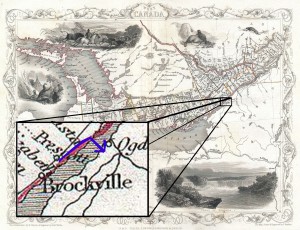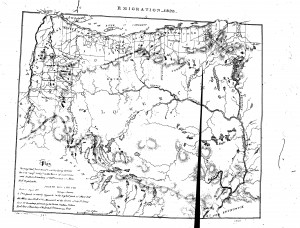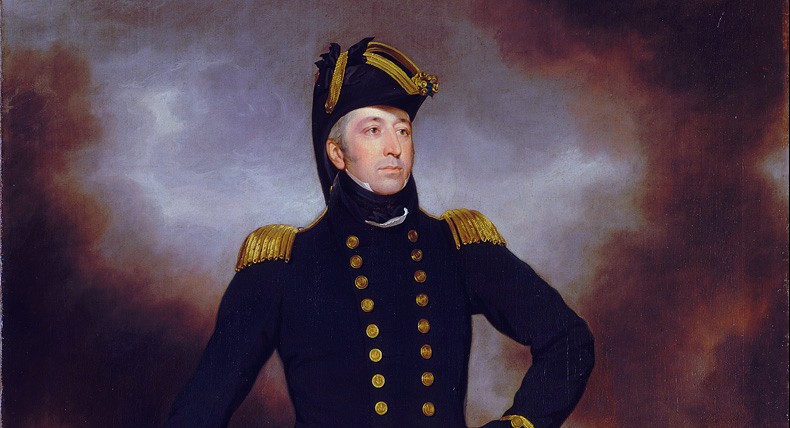![John James Halls [Public domain or Public domain], via Wikimedia Commons](http://ss.sites.mtu.edu/mhugl/wp-content/uploads/2017/10/Rear-Admiral_George_Cockburn_1772-1853_by_John_James_Halls-631x1024.jpg)
Early Career
Cockburn would join the 7th Dragoon Guards at age 19 in 1799(McKenna). He entered at the rank Cornet, which was a cavalry equivalent to the modern Second Lieutenant. Cockburn joined during the Napoleonic war, but rather than deploying, the 7th would spend the duration prepared and at the ready.
By 1807 Cockburn attained the rank of Captain. This same year he married Alicia Sandys and was sent to South America. Then he would serve in 1809 and 1810 on staff in the Peninsular War. During this time there are no notable mentions of Cockburn in his service.
War of 1812
Cockburn would leave for Canada arriving on 27 June 1811(McKenna). The Fencibles were a Canadian equivalent of an American militia organization. In particular the Fencibles were organized from a majority of the settlers in Canada at the time. In September that year Cockburn was promoted Major.
The Canadian Fencibles were active participants of The Battle of Crysler’s Farm(1813), Battle of Lacolle Mills (1814) and other minor engagements along the St. Lawrence river. His most recorded and referenced battle action during the War of 1812 is captured in quick summary:
“August 1813, four companies under Major Cockburn were sent to relieve the 2nd Battalion, 41st Regiment at Prescott. While stationed at Prescott, the Canadian Fencibles on 7 0ctober crossed the St. Lawrence River at Red Mills and surprised a piquet of the 1st Regiment of U.S. Dragoons.” (Henderson)

Edited to show Cockburns troop movements
This work is in the public domain in the United States because it was published before January 1, 1923.
This action is Cockburns most noted action in the War of 1812. The command at Prescott had learned that a group of approximately 180 soldiers from the American Army had moved into the countryside and had been split into small mobile bands to observe the British forces on the opposite side of the St. Lawrence and to prevent movements by the British on their side. Furthermore, they learned one such band was holding up at Red Mills, and decided to take action. They gave this information and orders to Major Cockburn. He would take a detachment of his Canadian Fencible regiment forces and leave Prescott at about 10 o’clock at night. From there he marched them approximately eight miles down river along the St. Lawrence, before making a night crossing over to Red Mills, New York. On the southern side, he would surprise one American lieutenant, one Sergeant, and nine Privates. In the resulting short conflict, both the Sergeant and a Private were killed and one Private was wounded from the American troops, while Cockburn reported no casualties and the capture of the other soldiers and nine of their horses and equipment(Henderson).
While the above earned him good remarks, Cockburn’s other actions seem to be side notes of their respective conflicts. Fame or disgrace for the battles generally only went to the given commander of each side in the battle.
For quick comparison, his wife, Alicia Cockburn, could be considered just as famous for her actions in the War of 1812. For example, in a letter she wrote (1814 to Charles Sandys), she touches upon daily life , talks about meditating on a journey into America, and may even slightly criticize the British high command in Canada with her statement “if I commanded, I would move it a little nearer the enemy”. In total her actions warrant as much attention for the time, usually to show what the wife of an officer life was like, or to highlight criticisms towards George Prevost.
In addition to this, Sir Francis Cockburn fame is much overshadowed by another family member, his older brother. Sir George Cockburn in the War of 1812 gained great notoriety and fame for his role in organizing the raiding of America’s eastern seaboard, and the sacking of Washington, D.C. This in turn would eventually help him rise to the position of The First Naval Lord of Britain, and pull much attention away from his younger brother.
The War of 1812 ended 1814 December, 24 with the signing of The Treaty of Ghent. On 26 June 1815, Cockburn was promoted to the rank of Lieutenant-Colonel, but the Canadian Fencibles were soon disbanded. Yet Cockburn’s career does not end here. Instead of returning home and retiring, he was promoted to Deputy Quarter-Master General.
Settling Canada
In this new position Cockburn’s main duty was the potential settlement, and eventual enactment of the settlement of former British soldiers and other immigrants in Canada. All of the following comes from the orders give to Cockburn listed below as the third primary scource. To begin this process Cockburn was instructed to survey Nova Scotia, New Brunswick, and Prince Edward’s Island for areas suitable for settlement. This area is approximately 51,680 square miles. Furthermore, his guideline, as given in his order was to look for “Land such as to ensure the Means of ultimate Success to any industrious Settler who may be placed thereon.” While such a large area should have been a boon to choose from, it was not. The areas listed are all in eastern Canada, where much of the population to that point had already settled. Adding to the list of problems he needed to plan and secure areas that could potentially support 10,000 people, and he was only allowed, at a maximum, to use 300,000 acres (468.75 square miles).

This work is in the public domain in the United States because it was published before January 1, 1923.
After all of his surveying and other data was collected, he was then to compile a large report. The largest component of this was maps. He was instructed to included maps of the areas surveyed and unsurveyed, maps of already existing townships, districts, and provinces, maps of land already given under different land grants, maps of areas left unpopulated or unused, meticulous maps of waterways with possible mill locations, and maps of where he planed, to his most accurate and precise calculations, to put these future settlements. He was also asked to provide such statistics as the average value of an acre for area, population already there, and the cost of labor.
While just the opening actions would be difficult, what was actually required beyond the initial phase and in implementation, would require even greater attention. Cockburn would need to plan sites for disembarking both people and their luggage from ships as they arrived to the colony. For each settler, he would be required to also provide a month’s worth of provisions. A portion of this would need to be given to the settlers upon arrival, the rest would need to be stored at the future location of the new settlement. The rules for these provisions would also further complicate things. Cockburn would be required to find potential suppliers for tools, food, ect.. that settlers would need. He would need to compare pricing of such also with Britain’s own potential suppliers and pick that which guaranteed the highest quality for the lowest price. He was also encouraged that while the ultimate success of the settler was important, that if supplies could be saved, at and at no harm to the settler, to do so. He would then need to transport all of the settlers and possessions to their new areas.
Past provisions and immediate necessities, Cockburn’s performance would be judged on the prosperity and success of the settlements. Thus Cockburn was placed in charge of road maintenance and building between old settlements and the new ones. He would also have to build a Department of Settlement. From here disputes between settlers would need to be solved, and more information, as time passed, on the progress of the settlements would need to be recorded. All of this was to be done with less than £10,000. Which, to possibly settle 10,000 people, meant that his budget per person was a pound.
Yet, it is here, Cockburn created a lasting impact. An example of a small chunk of his work is the following excerpt on the Township of Preston,
“Situate on the east side of the harbor, in the rear of the townships of Dartmouth and Lawrencetown, was formed in the year 1784, consisting of loyal Refugees and disbanded corps, and some few Negroes who followed the Loyalists from the States. The blacks in general became very industrious and thrifty, affording a considerable supply of vegetables, butter, poultry and eggs for the market at Halifax ; and from their temperance and persevering industry were in a fair way of making provisions for their families, when some agents of the Sierra Leone Company appeared in this province; and by their alluring offers, these people were induced to quit their Peaceful retreats and remove to Africa, where most of them fell victims to the climate or savage negroes.
The disbanded soldier were in general prone to idleness, and to the free use of ardent spirits, and when they had exhausted his Majesty’s bounty of Provisions, they sold their lands and quitted the settlement. Those who remain, by temperance and industry, might soon be enabled to live comfortably; for although the lands in, general are very stony, and afford little marsh or meadow, yet their proximity to Halifax, where every article they can raise is in demand, and where they can sell their produce, procure their necessary supplies, and return the same day with perfect ease, renders their situation advantageous. This township was granted to 388 proprietors in 1784.”(Appendix to Report 0f Lieutenant Colonel Cockburn on the Subject of Emigration, pg.5-6)
This level of detail was granted to each county, district, and township in his report back to the house of commons. He would for some areas, seemingly have complete histories, down to prominent people and families that had settled from America after the American revolution, or the Germans which he stated were ever industrious. Furthermore full lists of supplies would be compiled with pricing and quantities, and even the general population’s feelings on settling people.
“Give him good Land, and in Five Years he will be able to commence repaying you at the Rate of Five Pounds a Year, or more, provided you consent to receive it in Produce.”(Cockburn)
And so convincing was Cockburn that the endeavor would succeed, Britain approved the plan. He would help many retiring regulars and others settle into three surveyed townships. Due to his outstanding work, excellent report, and extensive knowledge gained of the colony, he was appointed to Deputy Quartermaster-General for both Upper and Lower Canada. Cockburn would continue to settle people in the townships being capable of boasting that most settled in within five years and paid back the cost of settling them and more.
Surveying
Charles Lennox would be appointed governor-in-chief of British North America on 1818, 4 May(George). This man was quite an established politician and officer. In the summer of 1819 he wished to conduct a survey of the colony he governed. Due to Cockburn’s extensive knowledge and position, he would accompany him on this large survey. The survey was to include much of the area that Cockburn had helped settled. The first stop noted on this trip is that at William-Henry, now Sorel, Quebec. It was here that Charles Lennox was reported to be bitten by a fox. The skin would heal, but Lennox’s death was already sealed. Though he would proceed further on the journey, he would develop muscle soreness, unquenchable thirst, and then hydrophobia. Lennox would then die of the rabies he had contracted. Cockburn’s report is the generally accepted story of the events that happened on the journey.
George Ramsay, 9th Earl of Dalhousie would be appointed next to this position and would also go on a large survey of Canada. But this one “was successful and in recognition, Dalhousie named Cockburn Island, in the Manitoulin district, northeastern Ontario, after Cockburn”. (McKenna)
In closing
This would be the last major event for Sir Francis Cockburn in Canada. He would go on and become the governor of the Bahamas, was involved in the Creole case, was awarded a knighthood, and achieved the rank of General in 1860 at age of 80. His wife would die in 1854, and Sir Francis Cockburn would die in 1868.
Cockburn, while a career officer, did more than just fight wars and lead soldiers. He helped further the planned and organized settlement of Canada. He would aid the Bahamas in a transition out of slavery, and help keep the islands economically stable. He was a man who could have retired at half pay, who instead, just keeps appearing outside the visible boundaries of fame. Even searching the internet for him now turns up minimal results. To this end, perhaps it should be remembered that no single event has just one actor, and that there are many who play important roles just out of sight that we should not forget.
Primary Sources
1. Appendix to Report 0f Lieutenant Colonel Cockburn on the Subject of Emigration, Printed by the House of Commons, 1828
2. Cockburn, Alicia. napoleon-series.org, edited by Dianne Burton-Graves, 15 Dec. 2006.
3. Wilmot, Horton R, and Francis Cockburn. Instructions Under the Direction of the Secretary of State for the Colonial Department: Communicated to Lieut. Col. Cockburn by the Rt. Honble R.w. Horton in a Letter Dated 26th January 1827, with a Letter Addressed to the Rt. Honble R.w. Horton by Lieut. Col. Cockburn, Detailing the Execution of These Instructions. London: publisher not identified, 2004. http://www.worldcat.org/oclc/890719148
Secondary Sources
4. Ed McKenna. “COCKBURN, Sir FRANCIS,” in Dictionary of Canadian Biography, vol. 9, University of Toronto/Université Laval, 2003–, www.biographi.ca.
5. George F. G. Stanley, “LENNOX, CHARLES, 4th Duke of RICHMOND and LENNOX,” in Dictionary of Canadian Biography, vol. 5, University of Toronto/Université Laval, 2003–, www.biographi.ca.
6. Henderson, Robert. “War Along the Upper St. Lawrence and the Canadian Regiment, 1812-1814.” warof1812.ca, 2010, www.militaryheritage.com.
7. Jackson, Andrew C., 2004, Title – The Peninsular War 1808-1814.
8. Luscombe, Stephen, and Charles Griffin. “The British Empire, Imperialism, Colonialism, Colonies.” The British Empire.
Further reading
- Sir Francis Cockburn Canada Belize Bahamas and Dover
- George Cockburn
- Battle of Lacolle Mills (1814)
- Battle of Crysler Farm
- Creole Case
- www.militaryheritage.com

